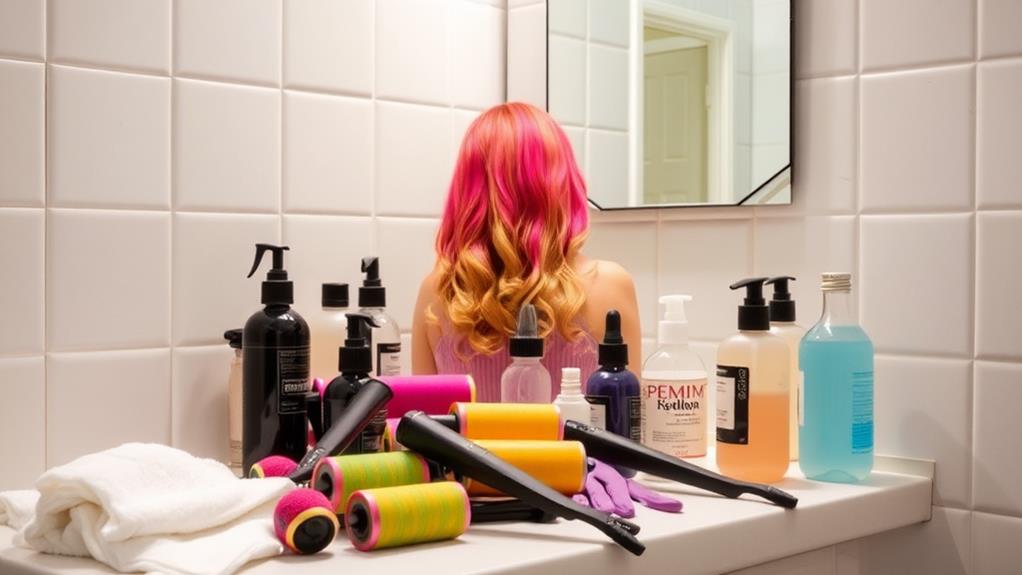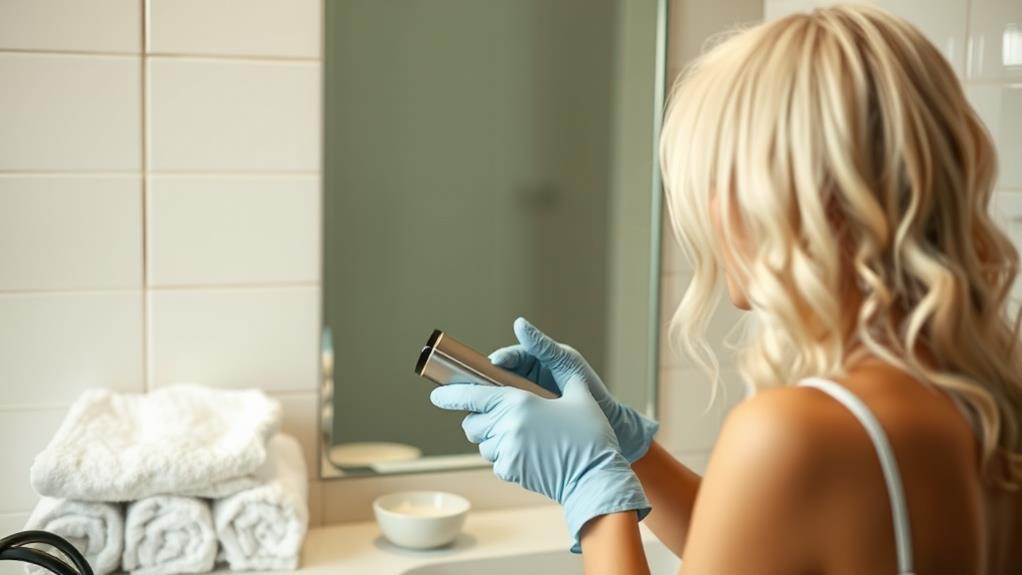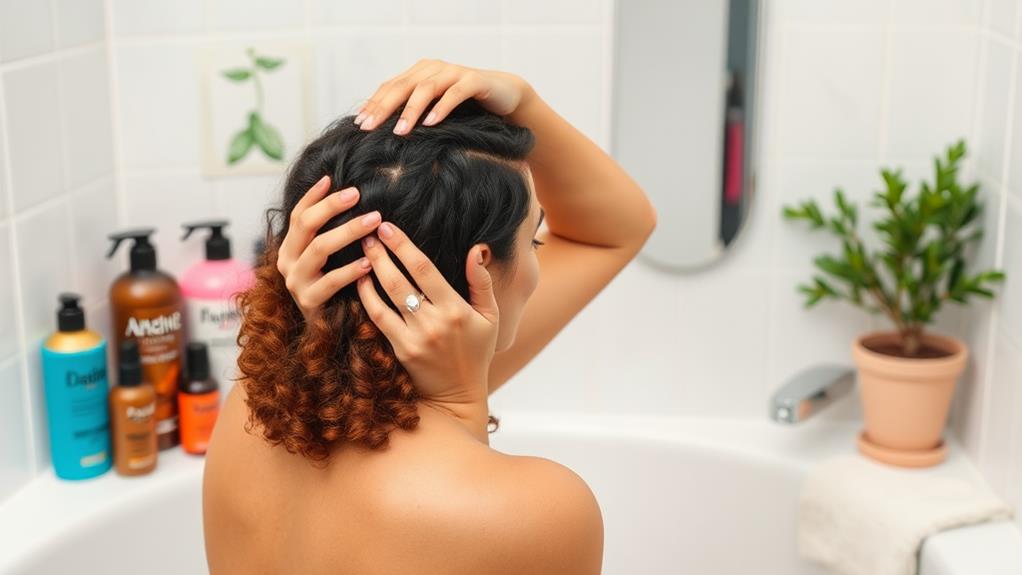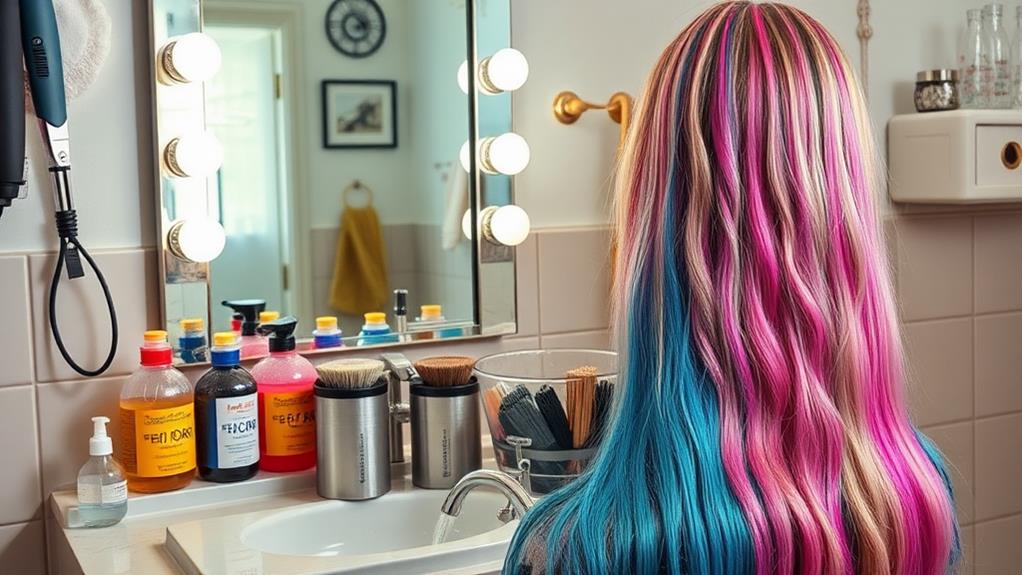If you're considering perming your bleached or colored hair at home, it's vital to understand the specific steps and products that can minimize damage. You'll need to select a perm kit tailored for fragile hair and follow a precise process to achieve those desired curls without compromising your hair's health. Start by sectioning your hair and wrapping it carefully, but be mindful of the timing with your perm solution. The right technique can make all the difference, and there are essential aftercare tips that'll guarantee your curls stay vibrant and healthy. Are you ready to learn more?
Understanding Hair Perming

Understanding hair perming involves grasping how this chemical treatment changes your hair's structure to create curls or waves. It's a fascinating process that has roots dating back to the early 1900s, thanks to Karl Ludwig Nessler.
When you decide to perm your hair, you're fundamentally altering its natural texture using chemicals. This can be particularly effective if you have fine or thin hair, as perms can add volume and body.
However, there are some important things to evaluate before diving into a perm, especially if your hair has been bleached or colored. Previous chemical treatments can weaken your hair's structure, making it more susceptible to damage during the perming process.
So, always assess your hair's health first! If it feels weak or brittle, it might be best to hold off on the perm until your hair is in a healthier state.
After getting a perm, taking care of your hair is vital. Using sulfate-free products can help maintain the integrity of your new curls or waves.
Regular deep conditioning treatments will keep your hair hydrated and looking vibrant. Remember, proper aftercare can make a significant difference in how your perm lasts and how healthy your hair feels.
Types of Perms
When choosing a perm, it's essential to know the different types available, each offering unique styles and effects. If you're looking to enhance bleached or colored hair, understanding these options can help you achieve the perfect look.
First up is the Body Wave Perm, which creates loose, natural-looking waves. This style adds volume without tight curls, making it ideal for a relaxed, effortless vibe.
Next, the Spiral Perm wraps your hair around long rods to produce tight, bouncy curls, resulting in a defined spiral shape that's sure to stand out.
If you want to focus on specific sections, the Spot Perm is perfect. This technique allows you to curl targeted areas, providing added volume and curl enhancement where you want it most.
For a layered appearance, consider the Stack Perm. It concentrates on the top layers of your hair, adding volume while keeping the lower layers straighter, which beautifully highlights your hair texture.
Lastly, the Pin Perm is designed for shorter hair and uses hairpins to create tightly defined curls, giving you a structured and stylish look.
Safety and Damage Considerations

Perming bleached or colored hair can be a risky endeavor, as the chemical processes involved may exacerbate existing damage. When you perm hair that's already been chemically treated, you might face increased brittleness and breakage. To keep your hair healthy, it's important to take certain precautions.
One of the most frequently asked questions is about the waiting periods. It's advisable to wait at least 1-2 weeks after bleaching before perming. This time allows your hair to recover and maintain its structural integrity. If your hair is severely damaged, consider waiting even longer. Consulting with a professional stylist is also significant, as they can assess the condition of your hair and determine if it's safe to perm.
Hair that's been heavily bleached often lacks the necessary elasticity, leading to looser curls and uneven patterns. Proper care is essential during this process. Using gentler perm solutions, like acid perms, can help reduce potential damage, but caution is still necessary.
Keep in mind that while it may seem tempting to rush into perming, taking the time to confirm your hair is ready will lead to better results. After all, you want your curls to look fabulous, not frizzy!
Perming Process for Bleached Hair
After confirming your hair is ready for a perm, it's time to start the process. Begin by selecting a perm kit specifically designed for bleached hair. This is essential since bleached hair has already undergone a chemical treatment, which means it needs special care to recover its strength and structure.
Follow the instructions provided in the kit carefully to minimize any potential damage.
Next, section your hair uniformly, making it easier to wrap strands around the curling rods. As you do this, apply the perm solution, being careful to avoid the scalp to prevent irritation.
Once all your hair is wrapped, wait about five minutes to check for wave formation. If you see the curls beginning to form, rinse your hair thoroughly without removing the rods. This helps set the curls properly.
Now it's time to apply the neutralizing liquid. This step is important because it guarantees your curls stay in place.
After you've finished the perming process, focus on maintaining your hair's health. Use sulfate-free and chemical-free products to preserve hair moisture, and don't forget to indulge in regular deep conditioning treatments.
This will help keep your bleached hair hydrated and prevent further damage. Remember, the goal is to enjoy beautiful curls without sacrificing your hair's health! Happy perming!
Care and Maintenance After Perming

Caring for your newly permed hair is essential to maintaining those beautiful curls and keeping your locks healthy. After the perming process, you'll want to make sure to give your hair the care and maintenance it deserves.
Start by using sulfate-free, paraben-free, and chemical-free shampoos. These gentle products help preserve the integrity of your curls while preventing unwanted frizz or dryness.
For the first 48 hours post-perm, you should avoid washing your hair. This waiting period allows your curls to set properly, reducing the risk of loosening them too soon.
Once you're ready to wash your hair, remember to detangle gently. Use a wide-toothed comb while your hair is still damp to prevent breakage and maintain curl definition.
Deep conditioning is vital, so aim to deep condition your hair twice a week with hydrating masks. This will help maintain moisture levels and combat the potential dryness that can arise from perming.
Additionally, don't forget about regular trims every 6-8 weeks. Keeping your hair trimmed will help eliminate split ends, ensuring your curls look vibrant and healthy.

